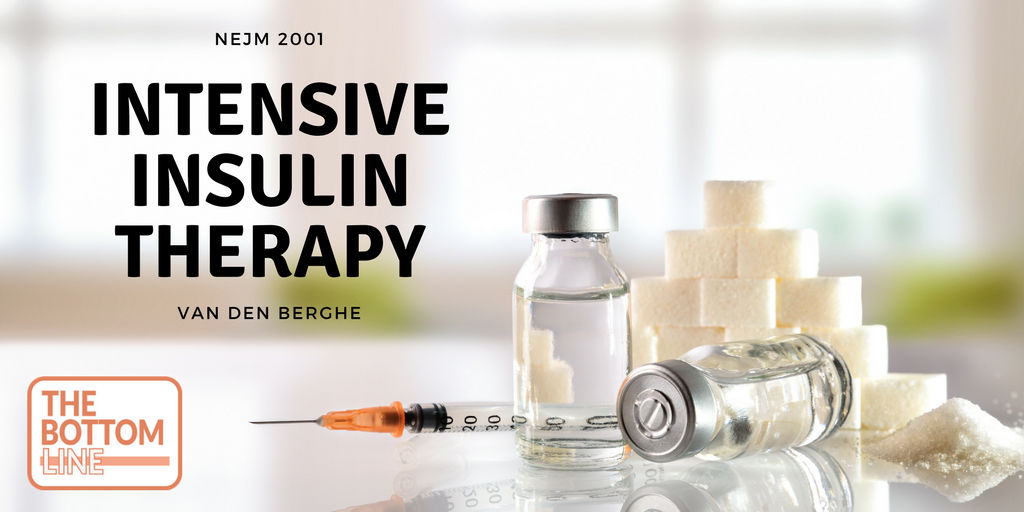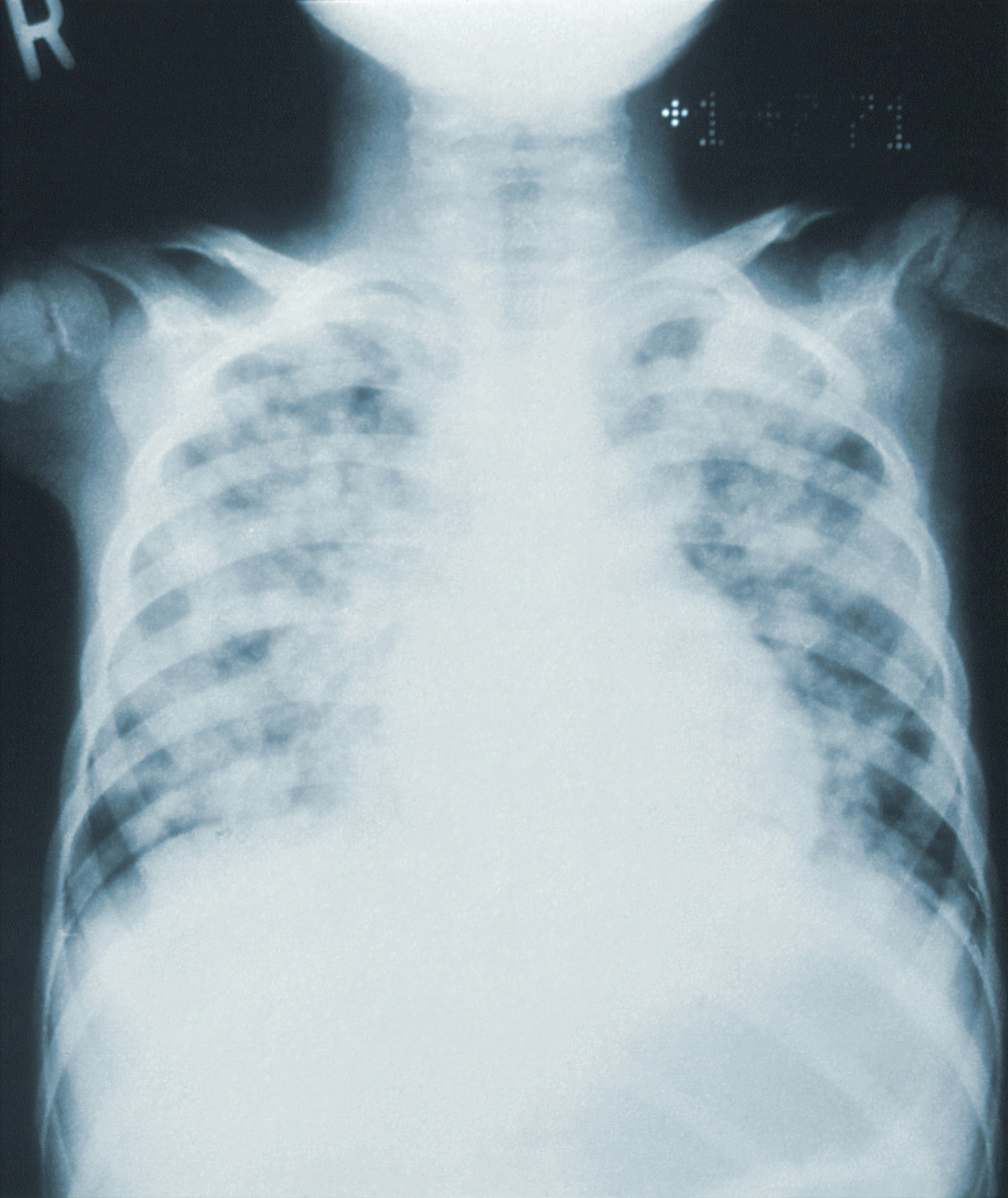Intensive Insulin Therapy

Intensive Insulin Therapy in Critically Ill Patients
Van den Berghe. NEJM 2001; 345: 1359-1367. doi:10.1056/NEJMoa011300
Clinical Question
- In post-operative patients requiring mechanical ventilation, does intensive insulin therapy compared to conventional insulin therapy reduce mortality?
Background
- Hyperglycaemia associated with critical illness is common and may be associated with complications such as polyneuropathy, increased susceptibility to infection and worsening organ dysfunction
- Glycaemic control after myocardial infarct has been shown to improve outcomes
- This trial investigated if tight glycaemic control in critical illness may also improve outcomes, but it should be read in combination with NICE-SUGAR that followed
Design
- Randomised, controlled trial
- Single-centre, predominantly post-operative intensive care unit
- Allocation performed using sealed envelopes
- Stratification in blocks of 10 according to the “type of critical illness”: cardiac surgery vs non-cardiac surgery
- Clinical staff were not blinded to allocation
- Outcome assessors including laboratory staff, electophysiologists and pathologists were blinded to allocation
- Planned to recruit 2,500 patients
- Powered to detect at 0.05 alpha significance level (beta error or Power level not specified):
- Absolute risk reduction in mortality of 5% for those staying 5 days or more in Intensive Care
- Absolute risk reduction in mortality of 2% for all Intensive Care patients
- Powered to detect at 0.05 alpha significance level (beta error or Power level not specified):
- Trial was terminated early after fourth planned interim study as threshold of P < 0.01 had been met
- Analysis was ‘intention to treat’
Setting
- Single Intensive Care Unit in Leuven, Belgium
- February 2000 to January 2001
Population
- Inclusion: all adults requiring mechanical ventilation
- Exclusion: Moribund; do-not-resuscitate order in place; participating in other trial
- 1562 screened, 1548 recruited (14 exclusions)
- Baseline demographics and measured variables were similar between groups
- Gender: 71% male
- Admission: >90% surgical, 63% for cardiac surgery
- Median APACHE 2 score: 9
- Existing diabetes: 13%
- Received insulin:
- Intensive insulin therapy group: 98.7%
- Conventional insulin therapy group: 39.2%
- Morning blood glucose:
- Intensive insulin therapy group: 103 mg/dl (5.7 mmol/l)
- Conventional insulin therapy group: 153 mg/dl (8.5 mmol/l)
Intervention
- Intensive Insulin Therapy
- Insulin infusion commenced if blood glucose exceeded 110 mg/dl (6.1 mmol/l)
- Infusion titrated to maintain blood glucose in the range 80 – 110 mg/dl (4.4 – 6.1 mmol/l)
- If > 140 mg/dl: Increased by 1.0-2.0 U/hr
- If 121 to 140 mg/dl: Increased by 0.5 to 1.0 U/hr
- If 111 to 120 mg/dl: Increased by 0.1 to 0.5 U/hr
- If 81 to 110 mg/dl: No change
- If 61 to 80 mg/dl: Insulin reduced by proportional amount
- If 41 to 60 mg/dl: Insulin was stopped
- If < 40 mg/dl: Insulin was stopped and 10 g intravenous glucose was administered
Control
- Conventional Insulin Therapy
- Insulin infusion commenced if blood glucose exceeded 215 mg/dl (11.9 mmol/l)
- Infusion titrated to maintain blood glucose in the range 180 – 200 mg/dl (10.0 – 11.1 mmol/l)
Management common to both groups
- Insulin was made as 50 units of Actrapid HM (Novo-Nordisk, Denmark) in 50 ml 0.9% NaCl
- Maximum insulin rate was arbitrarily set at 50 units/hr
- On discharge from Critical Care, the ‘conventional’ target was used whilst still requiring intravenous insulin (180 – 200 mg/dl [10.0 – 11.1 mmol/l])
- Infusion adjustments were made according to a strict protocol based upon results from whole-blood arterial sampling taken 1-4 hourly depending on stability
- Nutrition was standardised and the same between groups
- Intravenous glucose 200-300 g/day on day of admission
- Transition to either enteral, mixed enteral-parenteral or total parenteral feeding from day after surgery
- Total enteral feeding was primary aim and attempted as early as possible
- Aim was 20 – 30 non-protein kcal/kg/day (including 20 – 40% from lipids and 0.13 – 0.26 g/kg/day nitrogen)
- Suitability to leave Critical Care was decided when no organ support was required and two-thirds of caloric requirement was provided enterically
- This was to avoid any bias on secondary outcomes due to delayed discharges to a ward
Outcome
- Primary outcome: Mortality from any cause
- Intensive Insulin Therapy group: 4.6%
- Conventional Insulin Therapy group: 8.0%
- Absolute Risk Reduction: 3.47% (95% CI 1.06% to 5.88%; P = 0.0064)
- Number needed to treat: 29
- Fragility Index: 7
- Secondary outcome:
- In hospital mortality was lower in the intensive insulin therapy group
- Length of stay in ICU was improved by intensive insulin therapy but overall hospital length of stay was not different
- Need for prolonged ventilation or RRT was reduced by intensive insulin therapy but haemodynamic support requirement was not different between groups
- Critical illness polyneuropathy was less common in the intensive insulin therapy, however this may be biased by the reduced length of stay and therefore the reduced assessment rate in the intensive insulin therapy group
- Inflammatory markers, incidence of bloodstream infections and antibiotic prescribing were monitored
- Episodes of sepsis were lower in the intensive insulin therapy group
- Inflammatory markers were less deranged in the intensive insulin therapy group
- Prolonged antibiotic use was more common in the conventional insulin therapy group
- The proportion of patients requiring red cell transfusion was not different between groups, however the median number of units transfused was lower in the intensive insulin therapy group
Authors’ Conclusions
- Exogenous insulin with tight control of glucose not higher than 110 mg/dl (6.1 mmol/l) reduces mortality and morbidity in critically ill patients in a surgical intensive care unit
Strengths
- Randomised, controlled trial
- Concealed allocation
- Blinding of outcome assessment and protocolisation of care for unblinded clinicians
- Appropriate statistical analysis and adjustment for multiple interim analysis
- Very low P-value and moderately high Fragility Index suggests these findings are very unlikely to have occurred by random chance
- Manuscript reports excellent protocol adherence, but specific data not presented
Weaknesses
- All details of power calculation not presented, but less relevant given statistical difference was found
- Early termination may have led to false positive conclusion (as demonstrated by ADRENAL trial where first interim analysis demonstrated significant benefit but this was later found to be false after complete recruitment)
- Allocation envelopes not described as ‘opaque’ although probably were
- Gold standard now is online web-based randomisation, which is considered better than envelope strategy
- Single-centre, surgical intensive care unit with low acuity patients significantly limits the generalisability of these findings to other mixed or medical intensive care units
- Incidence of harm, from hypoglycaemia for example, was not presented within the manuscript
The Bottom Line
- This trial found significant benefit from intensive insulin therapy
- However, this was a single centre with a sample population of mostly post (cardiac) surgery patients, so the external validity is of concern
- Given this concern and the subsequent findings of NICE-SUGAR, intensive insulin therapy cannot be recommended
External Links
- [article] Intensive Insulin Therapy in Critically Ill Patients
- [further reading] NICE-SUGAR summary
- [further reading] Glucose Control in ICU by LITFL
Metadata
Summary author: Duncan Chambler
Summary date: 30 March 2018
Peer-review editor: David Slessor



